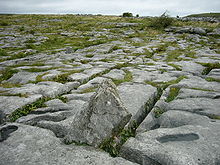Cart (gutter)
A cart or scrap is a morphological small form that is created by solution weathering in the karst . It is found in limestone , dolomite , gypsum and salt rock . Carts are the paths of water from the surface into the interior of the karst, which are drawn out in the network of fissures through the dissolution of rock. Even under the cover of superimpositions that are incapable of karstification, the formation of carts proceeds in a lawful manner, strictly dependent on the network of fissures (geological, organs, etc.), also in caves.
etymology
The word Karre is derived from the Old High German char or kar , which in turn goes back to the Indo-European root karro- , kar- , Celtic ker- , meaning rock .
history
In its scientific use, the term cart goes back to Salomon Hirzel , who first used it in 1829. He can already be found at Arnold Escher von der Linth . Sachs had already produced carts experimentally in 1865, but did not identify them as such. The French term lapies (or lapiés ) was first coined by Favre in 1867. A first classification was made in 1924 by the Serbian geologist Jovan Cvijič. Significant research on carts was carried out by Alfred Bögli between 1951 and 1980 . The technical terms he established for different cart morphologies have meanwhile established themselves internationally in geoscientific literature. More modern classifications come from JRL Allen (1984) with an emphasis on the hierarchical aspect and from WB White (1988) who classifies carts from a genetic point of view. PW Williams (2007) made the most recent attempt at classification, which differentiates between five morphogenetic groups.
Geology and occurrence


Where in earlier geological times or even now relatively flat rock surfaces were exposed by precipitation erosion , these show the more or less advanced chemical solution weathering typical of surface karst .
Even on weak slopes, there are often sharply separated ribs and furrows ( grooves, grooves, meanders, bowls, tubes, holes or even layer joint carts ). Even horizontally, in such areas, slabs may separate from one another through cracks .
With these fine structures, in addition to the chemical solution, forms of physical erosion (e.g. rinsing) by the rainwater and snowmelt water that run off are important. In the course of geological time these processes progress and chutes as well as deep cleft and layer joint carts form - extensive cart fields can be formed on larger exposed limestone surfaces .
Striking phenomena of this type at relatively low altitudes can be found in Ireland (from sea level), England (200–400 m), the French Jura (600–700 m) (called Lapiaz there) and southern Spain (1000–1300 m). In the Alps and the Dinaric Mountains (including the Julian Alps and Slovenia) they occur in all neighboring countries.
Sacrificial kettle, bowl cart, Kamenitza
In limestone or on the flat surfaces of mass rocks that have been stripped of their weathered surface layer, bowl-like or tub-like carts (weathering tubs) can form, which are filled with rainwater. They are called bowl carts, Kamenitza , because there was the idea that they were artificial in nature ( bowl stones ). This type of wind weathering ( deflation , air abrasion ) can be observed on free, unprotected rocks.
Classification
Since carts are hierarchically organized structures based on a combined solution and mass transfer process , John RL Allen (1984) tries to classify them on the basis of their degree of organization. All carts can be built either on the free rock surface or under a humus cover (subcutaneous carts). He differentiates between three levels of order, whereby lower levels of order can be found on higher levels of order or can be superimposed on the same:
- First order carts: their size is usually between 1 and 10 meters. Which includes:
- Flat carts ( Engl. Clints )
- Cleft carts ( grikes )
- Pointed carts ( pinnacles ) and littoral carts .
- Second order cart:
- Kamenitza (solution pool)
- Step carts and hopper carts
- Grooved carts
- Gutter carts
- Round carts
- Meander carts
- Roof carts (English pendants )
- Third-order carts, 1 to 10 centimeters in size, including:
- Napfkarren foraminous or pockige structures ( cocklings or rainpits )
- Rippel solution ( solution ripples ), and
- transverse carts ( flutes and scallops ) that form in cave systems .
PW Williams morphogenetically orders carts as follows:
- circular outlines - tiny pits and etched surfaces, step carts and shafts
- linear shapes that follow fractures - micro-cracks, split carts and cleft carts
- linear, hydrodynamically caused shapes - micro grooves , grooved carts, gutter carts and round carts, wall carts, meander carts and solution ripples
- Multiple forms - solution channels with pits, wells and split carts, hollow carts, pointed carts and pillars covered with ground
- Superordinate forms - cart fields, limestone pavement (with flat carts and layered stair karst), pillar karst, runic karst, corridor karst and littoral karst.
See also
literature
- Allen, JRL: Sedimentary Structures - their character and physical basis . Ed .: Elsevier. 1984, ISBN 0-444-42232-3 .
- Bögli, A .: Karst Hydrography and Physical Speleology . Ed .: Springer. Berlin 1978.
Individual evidence
- ↑ Lecture unit: Introduction to Geomorphology, University of Bern, Margreth Keiler, 2011



